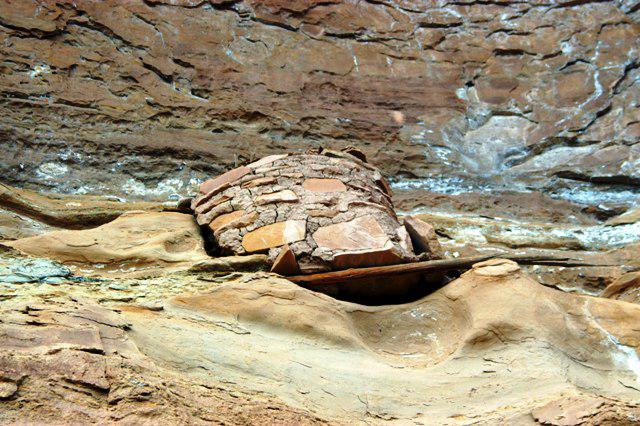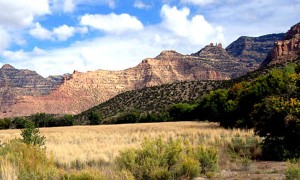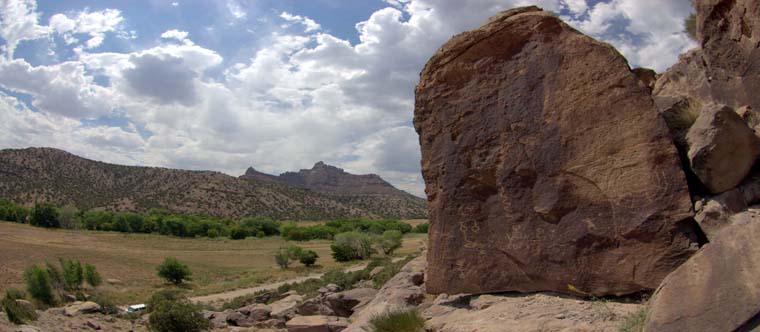Range Creek Field Station
General Information
 Tucked behind the Book Cliffs on the Tavaputs Plateau, Range Creek Canyon was once the home to a large Fremont population who practiced agriculture as well as who hunted and gathered wild resources. Until recently, this field station was largely on private property and it is still protected by its remote location and the fact that it is surrounded by Wilderness Study Areas administered by the U.S. Department of Interior. Because of its isolation, the thousand-year-old Fremont sites, structures, and artifacts are numerous and well-preserved.
Tucked behind the Book Cliffs on the Tavaputs Plateau, Range Creek Canyon was once the home to a large Fremont population who practiced agriculture as well as who hunted and gathered wild resources. Until recently, this field station was largely on private property and it is still protected by its remote location and the fact that it is surrounded by Wilderness Study Areas administered by the U.S. Department of Interior. Because of its isolation, the thousand-year-old Fremont sites, structures, and artifacts are numerous and well-preserved.
Selected Research
 The majority of the research conducted to date on the field station has been run under the auspices of the University of Utah, but also includes researchers from the College of Eastern Utah, Salt Lake Community College, Brigham Young University, Idaho State University, and the University of Arizona. At the University of Utah, the faculty in the Departments of Anthropology, Geography, and Geology and Geophysics are involved in Range Creek research projects.
The majority of the research conducted to date on the field station has been run under the auspices of the University of Utah, but also includes researchers from the College of Eastern Utah, Salt Lake Community College, Brigham Young University, Idaho State University, and the University of Arizona. At the University of Utah, the faculty in the Departments of Anthropology, Geography, and Geology and Geophysics are involved in Range Creek research projects.
The archaeological and paleoenvironmental resources of Range Creek are rich, abundant, and nationally significant. The vast majority of the recorded sites are associated with the Fremont archaeological complex, which dates between about A.D. 950 – 1,200 in this canyon. Sites include rock art, granaries, cists, and small village sites. Test excavations have demonstrated the presence of pit houses, surface structures, and associated storage facilities. The paleoenvironmental research has focused on analyzing sediment cores for variability in charcoal, pollen, magnetic susceptibility, and stable isotopes; tree-ring sequences; pack rat middens; and modern plant distributions.
Selected Education
 The University of Utah's annual summer field schools in archaeology (Anth 5712) and paleoenvironmental field methods (Geog 5712) are held at Range Creek Canyon. These courses offer students the opportunity to learn modern archaeological and ecological field and lab techniques in an ongoing field research program. These courses provide integrated instruction on reconstructing past human societies within their environmental and social contexts.
The University of Utah's annual summer field schools in archaeology (Anth 5712) and paleoenvironmental field methods (Geog 5712) are held at Range Creek Canyon. These courses offer students the opportunity to learn modern archaeological and ecological field and lab techniques in an ongoing field research program. These courses provide integrated instruction on reconstructing past human societies within their environmental and social contexts.
Further details can be found at University of Utah Department of Geography RED (Records of Environment and Disturbance) Lab
Contact Information
Duncan Metcalfe, Ph.D.
Director, Range Creek Research Project
Utah Museum of Natural History
1390 East Presidents Circle
Salt Lake City, UT 84112
Location
Central Utah, about 30 miles southeast of Price, UT.
Headquarters: 39° 21' 25" Latitude and 110° 07' 45" Longitude).
Size
2,870 acres
Elevation range
4,700 – 6,700 ft.
Annual Precipitation
Minimum and Maximum annual temperatures
Jan. 5° F; July 95 °F
Facilities
Dry laboratory and library. Camping, chemical toilets, kitchen facilities.
Personnel
Full-time site manager.
Databases
Weather data (weather station established June 2008), archaeological site management (GIS), and paleoecological (GIS)